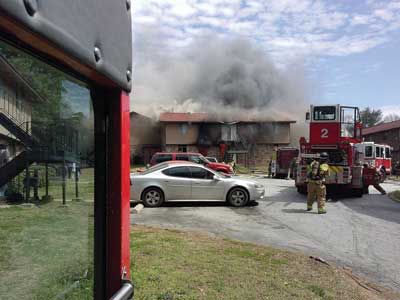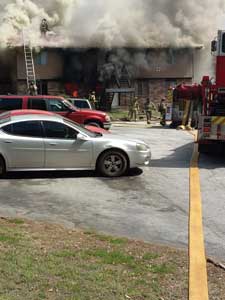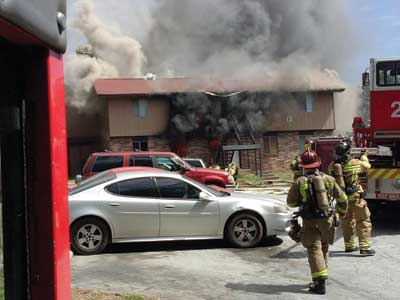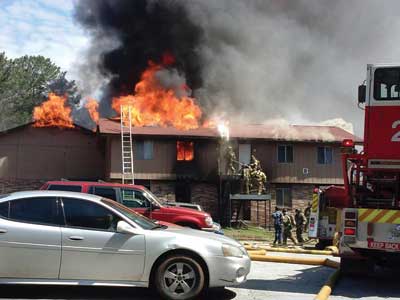BY STEVEN WOODWORTH
On Sunday, March 23, 2014, the Atlanta (GA) Fire Rescue Department (AFRD) was faced with a difficult and challenging fire that required numerous resources and the determination of firefighters to ultimately bring it under control. At 1423 hours, the Atlanta 911 center received a call reporting a structure fire at 1177 Constitution Road in southeast Atlanta. The caller reported a fire in an apartment in the Constitution Hills Apartments LLC complex. Initial reports were that up to four people were unaccounted for and possibly trapped in apartments adjacent to the fire apartment.
Constitution Hills Apartments LLC is a multifamily complex encompassing 4.63 acres and is in the area of the AFRD Fifth Battalion. The complex of 12 buildings, ranging from 8,000 to 10,000 square feet, was originally constructed in 1968. Access to the complex is limited to two entrances, one of which was gated and locked at the time of the incident. The locked gate was never opened. We used the walkways, which were the closest and most convenient routes of entry, to bring resources to the scene. The second entrance is a drive that wraps around the back side of the complex and connects to the first entrance, forming a horseshoe-shaped drive around the complex. Resident parking is along this drive. The buildings are laid out in assorted fashion throughout with only pedestrian access to the interior portion of the complex.
The weather on the day of the incident was unusually windy for Atlanta. The temperature hovered around 60°F. Sustained winds of 15 miles per hour (mph) gusted up to 30 mph.
The main fire building contained eight apartments and was approximately 8,000 square feet in the rear of the complex. The structure was Type V, wood-frame platform construction. The building had access for apparatus on the Alpha side of the incident. An attached exposure, on the Bravo/Charlie corner, was a similarly constructed two-story multifamily 10,000-square-foot dwelling that contained 12 apartments. This structure did not have access for apparatus on any side of the building.
FIRST ALARM
 |
| (1) Engine 2 arrives on scene and gives the initial report of a working fire. (Photos by Steven Stoner.) |
A first-alarm assignment consisting of Engines 2, 13, and 30; Trucks 2, 10, and 12; Battalions 5 and 3; Emergency Medical Services (EMS) 2; and Squad 4 was dispatched to the reported address. Engine 2 arrived first due, established command per the department’s standard operating guidelines (SOGs), and reported heavy smoke and fire conditions showing from the first floor Alpha/Bravo corner.
Engine 2 deployed one 1¾-inch attack line to the main fire apartment to protect the public stairway leading to the second floor. Truck 2 arrived as the first-due truck and deployed per department SOGs. One member of Truck 2 laddered the building and began vertical ventilation over the main body of fire.
The other members deployed to conduct a primary search of the apartment above the main fire apartment and the adjacent apartments. During this search, it was discovered that the fire had autoexposed to the second floor, the attic, and possibly the attached exposure.
All buildings were searched in priority order: the main fire building; then the most severe exposure; and then, as resources arrived on scene, the exposures most severely threatened.
Battalion 5 arrived on scene and, per department SOGs, assumed command. Confronted with the possible entrapment, heavy fire conditions, limited access, exposure problems, and conditions deteriorating rapidly, he requested a second alarm.
Engine 13 arrived on scene and established the initial rapid intervention team (RIT) capability on the Alpha side of the main fire building. Engine 30 arrived and attempted to enter the complex along the same route as the other first-alarm equipment. As they crossed an uncharged five-inch supply line, a coupling became lodged in the dual rear wheels. The resulting force of the moving engine caused the initial supply line to snap. Realizing the seriousness of the situation, the officer in charge immediately ordered the crew to hand-stretch an additional five-inch supply line to reconnect the original supply line. Once this was completed, Engine 30 deployed a second 1¾-inch attack line to help protect the search effort underway. Truck 10 arrived and, on hearing the reports of extension to the attached exposure, began a primary search of that structure. Truck 12 arrived and, along with Engine 13, filled out the RIT group per department SOGs. Battalion 3 arrived; per department SOGs, he fulfilled the duties of the safety officer.
 |
| (2) Truck 2 begins ventilation and primary search. |
SECOND ALARM
The second alarm was dispatched at 1430 hours. It consisted of Engines 20, 12, and 10; Trucks 1, 14, and 15; Battalion 4; and Division 1. Division 1 arrived, and the aide established a staging area at the entrance to the complex. Division 1 conducted a walk-around of the incident and noticed that heavy black smoke was now venting from the second floor and in the attic the entire length of the attached exposure.
After conferring with Battalion 5, Division 1 assumed command based on the rapidly deteriorating conditions and the need to expand the command structure to accommodate the additional companies that would be required to safely resolve the incident.
 |
| (3) Note the rapidly developing fire conditions. |
THIRD ALARM
A third alarm was requested at 1433 hours based on the present and forecasted conditions. This brought Engines 34, 1, and 14 and Trucks 16, 25, and 11. The initial company reports were indicating that the primary search was all clear and the fire conditions were not improving in either building.
The location and extent of the fire in the main fire building allowed the high winds to push the fire throughout both structures. The attic space of the attached exposure became, in effect, a wind tunnel. The high winds were directed at the gable vents on the end of the building, causing rapid fire spread throughout. This allowed fire to spread rapidly, creating additional exposure problems within the complex.
 |
| (4) Note the fire’s extension to the attached exposure on the left. |
STRATEGY
The command officers agreed that the objective now was to stop the forward progress of the fire. The strategy was adjusted to conduct a flanking attack on the attached exposure building. Although a flanking attack would require engine companies to perform hand stretches through the interior of the complex, the advantage was that more resources could be coordinated into the area while simultaneously maintaining egress routes for firefighters.
To accomplish this strategy, all second-alarm engine companies were assigned to the attached exposure now designated as Sector 2 and placed under the direction of Battalion 5. These engines would catch hydrants on Constitution Road and hand-stretch attack lines to the Charlie side of the incident. The hydrants were not private, and the main size was adequate. This would allow engines to bring attack lines in line with the strategy while establishing a separate water source. A public stairwell was identified as the point where companies would make a stand and attempt to stop the forward progress of the fire. Battalion 4 arrived and assumed responsibilities for the main fire building, designated Sector 1. The primary objectives for Sector 1 became (1) exposure protection and (2) knockdown of the main body of fire, if possible.
As companies began pressing into the interior portions of Sector 2, they reported limited amounts of fire on the first floor. Crews reported heavy fire throughout approximately 50 percent of the second floor and the attic area. After several tense moments of trucks’ opening up and engines advancing, Sector 2 reported that the forward progress of the fire had been halted. Once this benchmark had been achieved, command began to communicate a shift in strategy to the sector officers.
The two sectors would conduct a pincer attack to knock down the main body of fire. The area joining the two buildings still contained heavy fire conditions, and the wind showed no signs of decreasing. At this point, companies had stretched and were operating eight 1¾-inch attack lines, two 2½-inch attack lines, and one quick-attack monitor. Sector officers were advised to conduct the pincer attack while paying special attention to opposing lines. The safety officer was directed to ensure close coordination of this operation. The objective of command now became to overwhelm and extinguish the fire. The companies assigned to the third alarm would be used to rotate with the companies operating in Sectors 1 and 2. This would ensure a continuous attack as crews became low on air. EMS 2 established a rehab sector for weary crews who had been engaged in a long and difficult fight.
The continued effort by all companies and the increase in fire flow slowly began to turn the tide. As the pincer attack continued, companies began to report conditions improving. This was confirmed by signs seen on the exterior of each structure as heavy black smoke began to turn white with steam. After waiting to ensure that the wind would not once again create deteriorating conditions, at 1530 hours, command advised the communications center that conditions were improving. Shortly thereafter, the fire was declared under control.
 |
| (5) Note the fire extension throughout both structures. |
LESSONS LEARNED
• Communication is paramount to the success of incident operations. Company and chief officers must be capable of communicating key information rapidly and accurately. Company officers must communicate to chief officers information that includes conditions and decisions made. Chief officers must use this information in their decisions and to change strategy and tactics when necessary.
• The AFRD conducts building construction classes for all company and acting officers. The knowledge of building construction is vital for firefighters. Knowing where to look for void spaces, such as pipe chases and modification voids created by remodeling, is critical during rapidly expanding incidents.
• Resident parking often limits access in apartment complexes. Fire apparatus only compound this problem. As apparatus deploy into congested complexes such as Constitution Hills Apartments LLC, operators must look for ways to leave access for additional apparatus. Care must also be taken to place apparatus where they will not become exposure problems.
During this incident, command considered using tower ladder operations. Unfortunately, access limited this tactic on both buildings. The main fire building had access to only one side of the structure. The attached exposure did not offer access for tower ladder operations to any side of the structure. Limited space to maneuver led to Engine 30’s inadvertently breaking the initial supply line. Chief and company officers must understand that mistakes will happen. The primary consideration is how well crews adapt to situations when mistakes happen and how quickly those mistakes can be corrected.
•The wind was the most significant factor associated with this fire. The sustained winds caused fire conditions to deteriorate with such speed that crews had difficulty getting in position to stop the forward progress.
•Chief officers must call for help early in an incident based on present and anticipated conditions. Command must have enough resources to begin and sustain an attack, which will allow for rotating companies prior to the need for relief. Anticipating a relief rotation allows crews to continue fire attack without delay and to prepare defensive positions prior to the need.
•Along with additional resources comes the need to expand the command system. Command systems are often expanded after additional resources arrive and are put to work. When possible, expand command systems before committing additional resources to ensure that accountability is maintained and resources are coordinated with the strategy.
•Transferring command should be an incident-driven decision. Consider the following factors when determining when to transfer command:
- – safety (obviously). This may include companies freelancing, a rapidly expanding incident (as in the case of this incident), or the incident commander’s lack of situational awareness.
- – the size of the incident. Larger incidents, such as type IV incidents, require larger command systems to be effective.
- – the complexity of the incident. The more complex the incident, the greater the need for a reduced span of control.
- – the scope of the incident. Incidents of a political nature would fall under this factor.
Fires impacted by high wind conditions develop at a greater rate than those we are used to combating. Firefighters must be trained to control door openings and ensure that window ventilation is limited and closely coordinated with advancing attack lines.
This fire posed many challenges to responding companies. Training is the key to success in combating all types of fires and emergencies. Although the fire service devotes much of its attention to survival and rapid intervention training (a definite training need), we must not forget that the most effective way to increase fireground safety is to train in basic firefighting operations. Basic company functions, engine and truck work, increase fireground safety and allow departments to control rapidly progressing incidents.
STEVEN WOODWORTH, a 32-year veteran of the fire service, has spent the past 23 years with the Atlanta (GA) Fire Rescue Department, where he is assistant chief assigned to Division 1 on the A shift. He is a training officer for the Fayetteville (GA) Fire Department and has written numerous articles for Fire Engineering. He is an Operations Section chief with the Georgia Emergency Management Agency, Area 7 Type III IMT. He is co-author of Fighting Fires with Foam.
Fire Engineering Archives

